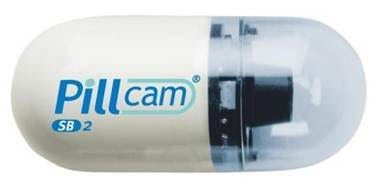
Suffer from stomach pain and diarrhea?
This could be Crohn’s disease, which can be diagnosed by swallowing a pill that has a camera.
Crohn’s disease often presents with two key symptoms: diarrhea and stomach or abdominal pain.
The diagnosis can be missed by more common tests, resulting in a misdiagnosis.

For example, 24-year-old Sarah had been suffering from diarrhea and abdominal pain, and underwent many tests, getting no answers.
Finally she was given the PillCam SB, and was diagnosed correctly with Crohn’s disease.
“PillCam is a marvelous innovation and very effective imaging tool to look at the small intestine, which cannot be examined in its entirety with upper endoscopy or colonoscopy,” says Nadeem Baig, MD, a board certified gastroenterologist and hepatologist at Monmouth Gastroenterology, a division of Allied Digestive Health.
“PillCam is used to look for bleeding or tumors in the small intestine. It can also pick up ulcers and inflammatory disorders of the small intestine, like Crohn’s disease for example.”
What is Crohn’s?
It’s a type of Inflammatory bowel disease that can affect any point along the GI tract, and other than abdominal or stomach pain and diarrhea, can also cause blood in the stools, ulcers, appetite suppression, weight loss, fatigue, arthritis, fever, skin disorders, mouth sores and an inflamed liver.
These symptoms, particularly if limited to diarrhea and stomach pain, can also mean many other conditions.
Thus, if you suffer from abdominal pain or cramping, and diarrhea, it’s crucial to get an accurate diagnosis.
There’s no cure for Crohn’s, and in three-quarters of patients, lesions exist in the small bowel.
Historically, it’s been difficult for doctors to visualize via instruments the small bowel.
Yet this area is crucial for ongoing monitoring for Crohn’s patients, even when symptoms are in remission.
In fact, this disorder can progress in the bowel without a symptom presentation.
To assess activity of the Crohn’s condition, doctors typically use a CAT scan, which emits radiation.
Camera in a Pill: PillCam SB
PillCam SB is capsule endoscopy, a non-invasive, non-radiation method of viewing the lining of the lower bowel, yielding a better view than what a CT scan can deliver.
How big is the FDA-approved PillCam SB?
It’s 11 mm x 26 mm and contains an imaging device plus light source. It rapidly transmits images, totaling over 50,000 pictures per procedure duration.
Patients as young as two years can use this device, considered the gold standard for evaluating the small bowel.
For those with Crohn’s disease or any disorder who are concerned about any risks from PillCam SB, those risks include retention or aspiration of the capsule, or skin irritation.
The endoscopic placement of the capsule may also pose some risks.
“The one time PillCam should not be used is If one suspects they have a blockage in the small intestine,” says Dr. Baig. “In such a scenario, it can get stuck and require surgery to remove.”
If you have unexplained stomach pain and/or diarrhea, make an appointment with a gastroenterologist.

 Dr. Baig’s
Dr. Baig’s
























